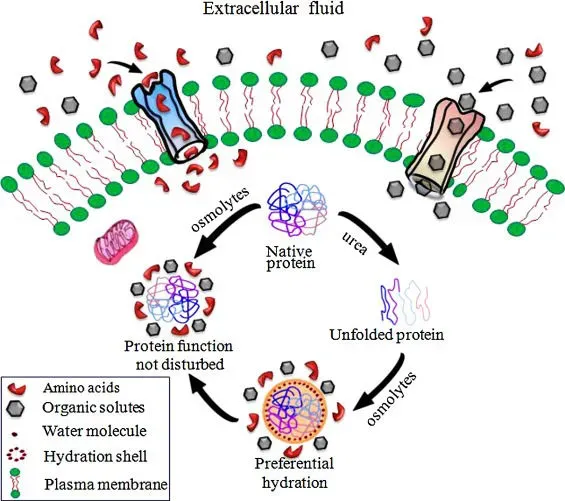Description

Context:
- A recent study highlights the role of small molecules known as osmolytes in helping proteins maintain their structure and function during stressful conditions.
- These findings offer valuable insights that could contribute to the development of treatments for diseases such as Alzheimer's and Parkinson's.
Details:
- A research team led by Subhas’s Haldar at the S.N. Bose National Centre for Basic Sciences utilized covalent magnetic tweezers to investigate the folding and unfolding of individual protein molecules and their interactions with osmolytes.
- The study focused on Protein L and its interactions with two osmolytes: Trimethylamine N-oxide (TMAO) and trehalose.
- TMAO significantly increased the strength of Protein L, enhancing its resistance to unfolding at higher concentrations, while showing minimal effect at low concentrations (up to 1M).
- At 1.5M, TMAO notably increased the unfolding force, indicating it helps maintain the protein's folded and stable state, whereas trehalose stabilized the unfolded state of Protein L.
- Published in Nanoscale, these findings enhance understanding of osmolyte effects on protein stability and may aid in developing drugs for neurodegenerative diseases and protein misfolding

About Osmolyte:
- Osmolytes are low-molecular-weight organic compounds that influence the properties of biological fluids.
- Their primary role is to maintain the integrity of cells by affecting the viscosity, melting point, and ionic strength of the aqueous solution.
- When a cell swells due to external osmotic pressure, membrane channels open and allow efflux of osmolytes carrying water, restoring normal cell volume.
- These small molecules play a vital role in helping cells endure stress by stabilizing proteins and preventing misfolding.
- By maintaining the structure and function of proteins under stressful conditions, osmolytes help ensure proper cellular function.
- When proteins misfold, they can no longer perform their necessary roles, which can lead to various diseases.
- Therefore, osmolytes are essential for preserving protein stability and represent promising targets for the development of new drugs.
- Examples: Common osmolytes include amino acids, sugars and polyols, methylamines, methyl sulfonium compounds, and urea.
Mechanism of Action
- Osmolytes are small organic molecules that stabilize proteins by lacking themselves from the protein surface, which encourages a more compact and stable protein structure.
- They help proteins maintain their proper shape and function, even under stressful conditions like high temperatures or extreme ph. I
- By counteracting denaturing forces, osmolytes keep proteins from misfolding or aggregating.
Case Study:
- Natural osmolytes that act as Osmo protectants include trimethylamine N-oxide (TMAO), dimethyl sulfoniopropionate, sarcosine, betaine, glycerophosphorylcholine, myo-inositol, taurine, glycine, and others.
- Bacteria accumulate osmolytes to protect themselves against high osmotic environments, where osmolytes function as neutral non-electrolytes, except in salt-tolerant bacteria.
- In humans, osmolytes are especially important in the renal medulla, playing a key role in kidney function.
- Fish cells also contain osmolytes, which help protect them from water pressure.
-
- The concentration of osmolytes in fish cells increases linearly with pressure and depth, allowing researchers to calculate the maximum depth at which a fish can survive.
- Fish cells reach a maximum osmolyte concentration at depths of approximately 26,900 feet (8,200 meters), and no fish have been observed beyond 27,349 feet (8,336 meters).
READ IN DETAIL ABOUT- About Alzheimer
ALSO READ ABOUT- Parkinson's Disease
Conclusion
- Osmolytes offer significant potential for developing treatments for neurodegenerative diseases.
- By stabilizing proteins and addressing oxidative stress, they could play a crucial role in managing and possibly slowing disease progression.
- Further investigation into their specific mechanisms and interactions is essential for advancing clinical applications.
Source:
https://dst.gov.in/osmolyte-protein-interaction-study-can-help-treatments-alzheimers-parkinsons#
MUST READ ARTICLES:
Researchers find brain protein in frontotemporal dementia ...
Parkinson Plus Syndrome
|
PRACTICE QUESTION
Q. With reference to Osmolyte, consider the following statements:
- They are high molecular weight organic molecules that help cells survive stress by stabilizing proteins.
- In humans, osmolytes play an important role in the renal medulla.
- Fish use osmolytes to protect their cells from water pressure at great depths.
Which of the statements given above is/are correct?
(a) 1 and 2 only
(b) 2 and 3 only
(c) 1 and 3 only
(d) 1, 2, and 3
Answer: (b)
|











